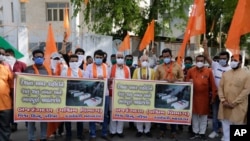Spiraling tensions between India and China over rival claims to territory in the icy Himalayas could push New Delhi to embrace closer ties with the United States and countries like Japan and Australia as ties with Beijing come under severe strain.
Whether the dramatic escalation that has led to a huge military deployment by the nuclear-armed Asian giants along their disputed border intensifies or is resolved diplomatically, it will lead to “strategic and economic choices by India that may explicitly have an anti-China orientation,” according to Harsh Pant, director of studies at the Observer Research Foundation in New Delhi.
Indian Prime Minister Narendra Modi’s response to the crisis will also influence the trajectory of New Delhi’s ties with its neighbors in South Asia, where Beijing has been challenging India’s predominant position, and determine whether the nationalist leader can fulfill his goal of raising India’s global profile.
Tensions that had been building since early May over India’s accusations of Chinese incursions in its territory have increased dangerously since a brutal hand-to-hand combat in Eastern Ladakh in which 20 Indian soldiers were killed on June 15.
Both countries have said they want to deescalate the crisis but have also hardened postures.
China has laid claim to the site of the bloody clash, the Galwan Valley, which New Delhi says was never part of the disputed border. This is not the only flashpoint — Indian and Chinese troops are also confronting each other at two other Himalayan ridges along the 3,488-kilometer-long Line of Actual Control. New Delhi wants the status quo restored and has vowed to defend its border with military force if necessary.
As the crisis plays out, calls to deepen engagement with the West to build leverage against China have grown. The Hindustan Times in an editorial said that New Delhi would have to reconsider its entire geopolitical posture, “double down on its partnership with the US” and be “a part of any club that seeks to contain Chinese powers.”
In the past decade even as India moved steadily closer to Washington, there were always voices advocating caution. That is likely to change.
“Many in New Delhi had been arguing to go ahead one step at a time. The whole idea was that we have managed China and the border issue relatively OK, so don’t annoy Beijing to the extent that it can create problems for you,” says Harsh Pant. “But now trouble has been created. So, in a sense this opens up the space for the Modi government to more robustly engage with like-minded countries where in the past it was hesitant.”
Signs of that were already evident. This month, a major agreement signed by India and Australia will allow each country to use the other’s military bases.
India, say analysts, is also likely to drop its hesitation about how closely to embrace the Quadrilateral Security Dialogue, known as “Quad” — an informal strategic grouping of India, the U.S., Japan and Australia that was revived in 2017 amid fears of China’s growing heft and assertiveness in the Indo-Pacific region.
“As a country we have avoided going one way or the other, but depending on who comes forward to help and what kind of help, that will determine where we move closer to,” says Jayadeva Ranade, a former senior security official who heads the Center for China Analysis and Strategy in New Delhi.
The manner in which the crisis plays out in the coming weeks will also impact India’s ties with smaller countries in its neighborhood, like Nepal and Sri Lanka, that China, with its deep pockets, has wooed by building roads and ports.
“The geopolitical competition in South Asia between India and China will sharpen,” says Happymon Jacob, a professor at the School of International Studies in New Delhi’s Jawaharlal Nehru University.
He points to Nepal's recent approval of a map that shows territories traditionally claimed by India as belonging to Nepal, deepening strains that surfaced in recent years as the tiny Himalayan country, tucked between the Asian giants, moved closer to Beijing. India’s army chief, Manoj Navarane said the issue might have been raised at "someone else’s behest", which has been interpreted as an allusion to China.
“If we don’t respond to China effectively, Pakistan, Nepal, Sri Lanka may look at us differently, as a country that they need not bother about as long as they are friendly with Beijing,” Ranade warns. “They will reevaluate what kind of relationship they should have with us.”
However, countering China’s challenge on a military level in the high Himalayas may not be easy — although India has one of the world’s largest armies, Beijing is considered a superior military power.
So, as it searches for ways to pressure China, India with its large market, is also considering economic options.
India had long hoped that the robust economic engagement, which has seen bilateral trade grow to more than $90 billion, would act as a counterweight to their more contentious border dispute. Those hopes have now been shattered.
New Delhi was already taking a more cautious approach to growing Chinese investments in India even before the clashes erupted — in April, in the wake of the coronavirus pandemic, India passed legislation requiring government approval for investments from Chinese companies. That trend could accelerate.
“The sentiment is changing. For example, India decided to bring in Huawei for trials of 5G wireless network, now that might not happen,” says Pant. “All those issues will become much more black and white for India.”
Analysts however warn that India’s economic options against China’s much larger economy are limited and could hurt New Delhi more than Beijing, especially when the Indian economy is in a downward spiral.
But as it mulls military, economic and political options in the weeks and months ahead, New Delhi may have to abandon its decades-long policy of “strategic autonomy” as it prepares not just to defend its borders but also push back against what commentators call the idea of Chinese domination of Asia.




